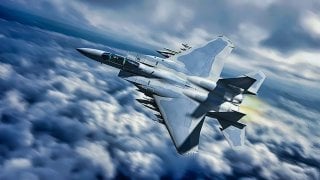How Much Does It Cost to Train a U.S. Air Force Pilot?
The United States operates some of the most advanced and capable tactical aircraft ever to take to the skies, but what does it cost to train the pilot? More than you might think.
Summary: The United States, recognizing the strategic importance of its tactical aircraft, also understands the significant investment required to train its pilots. A study conducted in 2019 by the U.S. Air Force and the RAND Corporation analyzed the financial implications of retaining experienced pilots versus the costs associated with recruiting and training new ones. This analysis was crucial, especially as the commercial airline industry aggressively recruits qualified military pilots, offering them attractive alternatives to military service. The report highlighted the dilemma between maintaining a highly skilled yet expensive pilot force and the lower costs but higher initial investments of training new pilots. Training costs can vary significantly, with the expense of preparing a pilot for advanced aircraft like the F-22 Raptor being substantially higher than for less sophisticated aircraft, underscoring the complexity of balancing experience, skill sets, and budgetary considerations in maintaining an effective and sustainable pilot corps.
How Much Does U.S. Air Force Pilot Training Cost?
The United States operates some of the most advanced and capable tactical aircraft ever to take to the skies, but what does it cost to train the pilot? More than you might think.
Back in 2019, the U.S. Air Force worked with the RAND Corporation to conduct an analysis of what the branch spends on bonuses and incentive pay aimed at retaining existing pilots, versus the cost of recruiting and training new pilots to replace them. According to the 73-page report, this comparison was of particular import at the time (and today) because the commercial-airline industry has been aggressively pursuing qualified pilots to replace its aging workforce, encouraging highly-trained Air Force pilots to get out of the military and take on cushier jobs ferrying passengers between New York and LA.
NEW PILOTS VERSUS OLD, IN TERMS OF DOLLARS AND CENTS
There are a number of variables to take into consideration when trying to determine the right pilot force structure. High levels of retention mean high levels of expertise, but it also means higher personnel costs across the board as aviators continue to progress in their careers toward higher pay grades. An all-senior pilot force also creates problems as those senior pilots begin to reach retirement age. Conversely, an all-junior (or recruited) pilot force offers lower costs in terms of payroll and bonuses, but comes with the high initial cost of recruitment and training.
Obviously, the right structure is a mix of the two, with several senior aviators sticking around being the pay structure, bonuses, and incentives make it worthwhile as compared to commercial or civilian endeavors, and a number of aspiring aviators coming in each year to train for their military careers. This offers a mixture of experience, skill sets, and costs that allows the pilot corps to be sustainable over the long haul, but to manage this balance, the Air Force must have a thorough understanding of what such a mixture will cost for the purposes of budget allocation.
Of course, the first step in making this determination is assessing exactly how much it costs to train a person off the street to fly a hundred million dollars worth of state secrets into enemy airspace and live to tell the tale.
PILOT TRAINING COSTS VARY WIDELY
In order to assess the cost of training a pilot, RAND had to consider several things outside the direct expenses incurred by the student (housing, payroll, etc), like the cost per flight hour for aircraft leveraged and the support costs incurred by maintaining these training fleets. Costs from each stage of training, from flight screening all the way through assignment to formal training units, were included.
The analysis found that the cost of training pilots varied greatly based on the platform. For instance, it costs about ten times more to train a pilot to fly America’s premiere air superiority fighter, the F-22 Raptor, than it costs to train a pilot to fly a C-17 cargo plane. This, of course, makes a great deal of sense seeing as aircraft like the F-22 costs far more per hour to operate than more utilitarian platforms like the C-17.
HERE’S HOW MUCH THE U.S. AIR FORCE SPENDS TRAINING ITS PILOTS
The chart below shows the Air Force cost of training one pilot on each platform, according to the RAND Corporation analysis from 2018, as well as today’s updated figures when adjusted for 2023’s inflation, using the U.S. Bureau of Labor Statistics inflation calculator.
Aircraft
2018 Dollars
2023 Dollars
A-10
$5,961,000.00
$7,194,795.47
B-1
$7,338,000.00
$8,856,804.09
B-2
$9,891,000.00
$11,938,218.76
B-52
$9,688,000.00
$11,693,202.24
C-130J
$2,474,000.00
$2,986,063.41
C-17
$1,097,000.00
$1,324,054.80
C-5
$1,397,000.00
$1,686,148.18
F-15C
$9,200,000.00
$11,104,197.01
F-15E
$5,580,000.00
$6,734,936.88
F-16
$5,618,000.00
$6,780,802.04
F-22
$10,897,000.00
$13,152,440.00
F-35A (basic)
$10,167,000.00
$12,271,340.00
F-35A (transition)
$9,467,000.00
$11,426,460.12
KC-135
$1,196,000.00
$1,443,545.61
RC-135
$5,447,000.00
$6,574,408.82
The above figures were obtained from The Relative Cost-Effectiveness of Retaining Versus Accessing Air Force Pilots by the Rand Corporation.
About the Author: Alex Hollings
Alex Hollings is the editor of the Sandboxx blog and a former U.S. Marine that writes about defense policy and technology. He lives with his wife and daughter in Georgia. This first appeared in Sandboxx.


